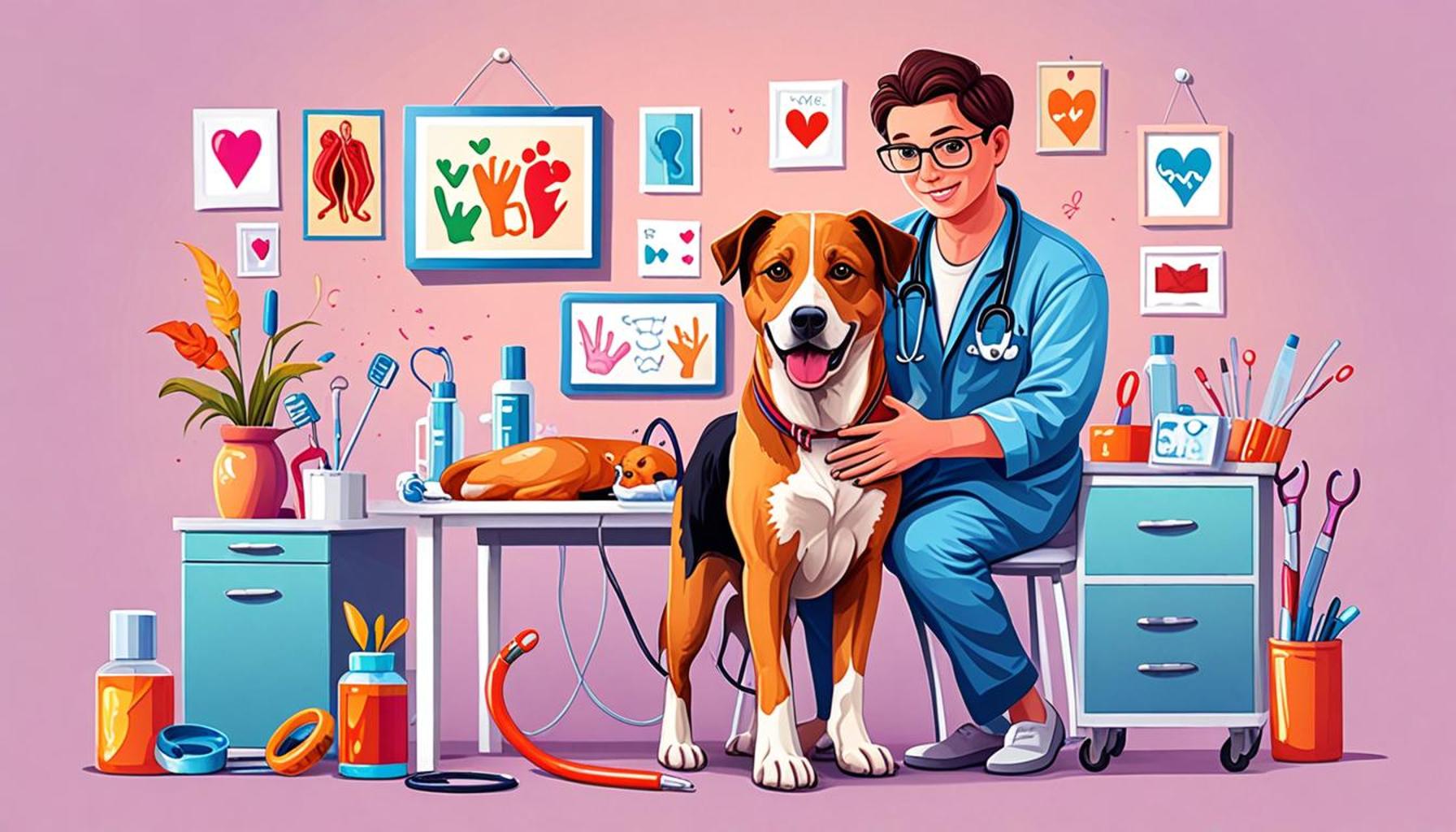Strategies for Dealing with Separation Anxiety in Dogs and Cats

Understanding Pet Separation Anxiety
For many pet owners across the United States, separation anxiety is more than just a nuisance; it can become a serious issue that affects the health and behavior of our beloved companions. This condition is particularly prevalent among dogs, though cats can also exhibit signs of distress when their owners leave. The manifestation of separation anxiety can lead to a spectrum of troubling behaviors, such as excessive barking, destructive chewing, and inappropriate urination, which make life difficult for both pets and their owners.
Recognizing the Signs
Understanding the signs of separation anxiety is crucial for effective management and intervention. Here are some common indicators that your pet may be experiencing anxiety:
- Vocalization: Pets suffering from separation anxiety may bark incessantly, meow, or whine when they are left alone. This vocalization is not just a call for attention; it is often a symptom of their distress.
- Destruction: Many pets will resort to destructive behaviors, such as chewing on furniture, shoes, or even their own bedding. This behavior is usually an attempt to cope with their anxiety.
- Inappropriate elimination: Pets may urinate or defecate inside the house, even if they are otherwise house-trained. This can be particularly frustrating and is often a sign that they are overwhelmed with stress when left alone.
Effective Strategies for Management
Addressing separation anxiety requires a thoughtful approach that incorporates patience, training, and sometimes professional help. Implementing a few foundational strategies can significantly improve the situation:
- Gradual desensitization: Begin by gradually getting your pet accustomed to being alone for shorter periods. Start with a few minutes and gradually increase the time as they become more comfortable. This slow acclimatization can help diminish their anxiety over time.
- Creating a safe space: Designate a cozy area in your home where your pet feels secure. This space could be a specific room, a comfortable crate, or a cozy corner with their favorite toys. By providing a safe haven, pets can retreat there when feeling anxious.
- Product options: Explore products such as pheromone diffusers or calming supplements designed specifically for pets. These options can provide additional comfort and alleviate some of the stress associated with being alone.
Beyond Basic Strategies
Understanding and implementing these strategies is just the beginning of tackling separation anxiety. For many pet owners, seeking the guidance of a professional dog trainer or animal behaviorist can offer tailored strategies suited to individual pets. Additionally, it’s essential to foster a positive association with time spent alone by rewarding calm behavior and providing engaging toys that will keep pets occupied.
In conclusion, as pet owners, knowledge and proactive approaches are vital for supporting our companions through difficult moments. By diving deeper into the mechanisms of separation anxiety and working towards effective solutions, we can foster a more harmonious household where our beloved pets not only manage their anxiety but thrive even in our absence.
DISCOVER MORE: Click here to uncover the benefits of pet adoption
Effective Strategies for Management
Addressing separation anxiety requires a thoughtful approach that incorporates patience, training, and sometimes professional help. It’s essential for pet owners to understand that overcoming this condition is not an overnight process, but rather a gradual journey. Implementing a few foundational strategies can significantly improve the situation for both pets and their owners:
- Gradual desensitization: One of the most effective methods for easing separation anxiety is gradual desensitization. This technique involves slowly getting your pet accustomed to being alone for increasingly longer periods. Start by leaving your pet alone for just a few minutes, then gradually increase the duration over time. This slow acclimatization process can help diminish their anxiety, making them more comfortable with your absence.
- Creating a safe space: Designating a cozy area in your home where your pet feels secure can significantly alleviate their stress. You might consider creating a comfortable nook in a quiet part of your home, equipping it with their favorite toys, items that smell like you, and a comfortable bed. This space serves as a sanctuary where pets can retreat when feeling anxious, offering them comfort when you are away.
- Interactive toys and puzzles: Keeping your pet engaged is another vital strategy. Invest in interactive toys or food puzzles that challenge your pet cognitively and keep them occupied during your absence. These stimulating activities can divert their attention from feelings of loneliness and provide much-needed mental exercise.
- Routine and predictability: Maintaining a consistent daily routine can help your pet feel more secure. By sticking to regular feeding, walking, and playtime schedules, you can create a sense of stability in their lives. This predictability can ease anxiety as pets become accustomed to knowing what to expect from their day.
- Calming products: Explore various calming products designed to help soothe anxious pets. Pheromone diffusers, calming collars, and even anxiety wraps can provide additional relief. These items can help create a calming environment that reduces stress when you’re not home.
Developing a combination of these strategies tailored to your specific pet’s needs can lead to effective management of separation anxiety. As you experiment with different techniques, remember that patience and perseverance are key. Each pet responds differently, and it may take time to find the right combination of strategies that work for your furry friend.
Beyond Basic Strategies
Understanding and implementing these strategies is just the beginning of tackling separation anxiety. For many pet owners, seeking the guidance of a professional dog trainer or animal behaviorist can offer tailored strategies suited to individual pets. By diving deeper into the mechanisms of separation anxiety and working towards effective solutions, we can foster a more harmonious household where our beloved pets not only manage their anxiety but thrive even in our absence.
Effective Strategies for Managing Separation Anxiety in Pets
Separation anxiety is a common issue among both dogs and cats, leading to stress for both the pet and the owner. Understanding the triggers and employing effective strategies can significantly alleviate this anxiety. Here are some innovative and practical methods to help your furry friends cope with their fears.
| Category | Advantages |
|---|---|
| Desensitization Training | Gradual exposure to alone time decreases anxiety over time. |
| Interactive Toys | Keeps pets engaged and distracted, shifting their focus from your absence. |
| Comfort Items | Familiar scents can offer reassurance, providing emotional support. |
| Routine Establishment | Consistent schedules help pets feel secure and know what to expect. |
| Calming Aids | Products such as pheromone diffusers and supplements can reduce anxiety. |
By incorporating these strategies into your routine, you can foster a more comfortable environment for your pets. Each pet is unique, and it may require experimenting with various approaches to find what works best for your companion. Additionally, consulting with a veterinarian or a pet behaviorist can provide further personalized guidance, ensuring your pets feel safe and supported.
DON’T MISS: Click here for essential tips on pet nutrition
Recognizing Triggers and Behavioral Adjustments
Understanding the triggers of separation anxiety in your pets is crucial for developing rich and effective solutions. Every pet is unique; therefore, identifying the specific circumstances that precipitate their anxiety can help owners tailor their strategies accordingly. Common triggers include sudden changes in routine, moving to a new home, or the loss of a family member. By recognizing these factors, you can proactively manage your pet’s environment and emotional state.
Behavior Modification Techniques
In addition to practical strategies, behavioral modification techniques can play a significant role in addressing separation anxiety. These approaches focus on changing the dog’s or cat’s emotional response to being alone.
- Counter-conditioning: This is a process that aims to replace anxiety with a positive emotional response. For instance, you can train your pet to associate your departures with something enjoyable, like a special treat or a favorite toy. When you leave, toss a treat or a toy in their cozy space. Over time, your pet may begin to look forward to your time away, linking it with positive experiences.
- Training commands for calmness: Teaching your pet commands such as “stay” or “settle” can instill a sense of control and calm during your absences. Practicing these commands while you’re home can help reinforce their understanding. Gradually, you can practice these commands for short periods while you leave the room. The reinforcement of positive behavior in a calm state can help diminish anxiety over time.
- Gradual departures and arrivals: Often, pets can become anxious during your departures or arrivals. To alleviate this, practice leaving for short periods without making a fuss about leaving or returning. By being nonchalant about these actions, you encourage your pet to remain calm. Avoid extended goodbyes or hello rituals that can heighten their anxiety.
Consideration of Medication
While many pets will respond positively to the aforementioned strategies, some cases of separation anxiety may require medical intervention. Pet owners should consult with a veterinarian or an animal behaviorist regarding anxiety medications if behavioral adjustments do not yield the desired results. Medications can help to stabilize a pet’s mood and reduce anxiety levels, providing a more conducive environment for training. Some common options include selective serotonin reuptake inhibitors (SSRIs) or other anti-anxiety medications that can be prescribed specifically for pets.
Engaging with Professional Support
For many, seeking professional help is pivotal in addressing separation anxiety effectively. Behaviorists can offer personalized plans that incorporate training, environmental adjustments, and, if necessary, behavioral medications. Joining support groups or dog training classes can also provide valuable community insights. Having a support system not only helps your pet but also provides emotional encouragement and new ideas for pet owners.
Finally, remember to monitor your pet’s progress regularly. As they adapt to the strategies you’ve implemented, you should also adapt your techniques. Regular observations can assist you in noticing improvements or required adjustments in your approach, leading to a more harmonious living experience.
DISCOVER MORE: Click here for insights
Conclusion
Dealing with separation anxiety in dogs and cats can be a nuanced journey for pet owners. By understanding the complexities of your pet’s emotional responses and recognizing the myriad triggers of anxiety, you can create a tailored approach that enhances their well-being. Implementing behavior modification techniques, such as counter-conditioning, training for calmness, and practicing gradual departures can establish a framework that eases their distress.
However, every pet is different; thus, it’s essential to remain patient and consistent while monitoring their progress. If you find that behavioral strategies yield limited results, consulting with a veterinarian or a certified animal behaviorist may provide additional support through potential medication options or specialized programs. Remember, professional guidance not only opens doors to effective solutions, but also fosters a supportive environment for both you and your pet.
Moreover, engaging with community resources, like support groups or training classes, can enrich your understanding and provide invaluable insights into dealing with separation anxiety. As you navigate this path, continually adapt your methods based on your pet’s responses to promote a harmonious living experience.
Ultimately, the key is to approach the situation with empathy and care. By implementing these strategies for dealing with separation anxiety, you will not only help your furry companions feel more secure but also strengthen the bond you share. Through understanding, patience, and love, the journey towards alleviating separation anxiety can lead to a more joyous and fulfilling life for both you and your beloved pets.


